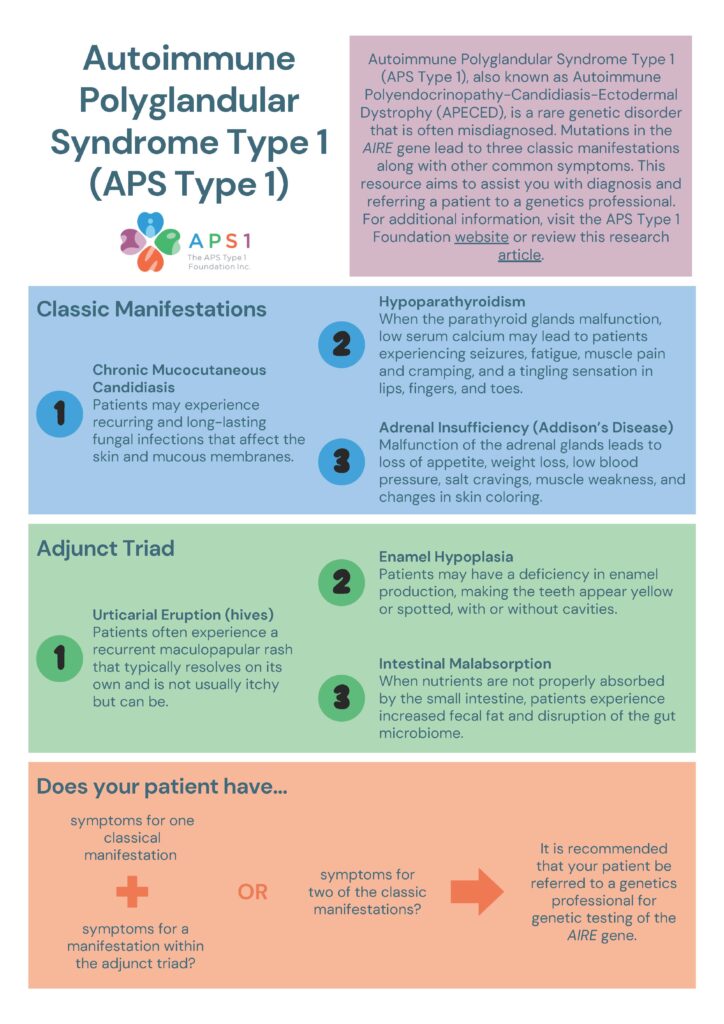Disease Manifestations
APS Type 1 is a rare genetic disorder caused by mutations of the AIRE gene. Mutations in AIRE lead to multi-organ system autoimmunity typified by three classic manifestations:
- Autoimmune Hypoparathyroidism: a malfunction of the parathyroid glands. These glands secrete a hormone that regulates the body’s use of calcium and phosphorus. Hypoparathyroidism can cause a tingling sensation in the lips, fingers, and toes; muscle pain and cramping; weakness; fatigue; and even seizures.
- Adrenal Insufficiency (also known as Addison’s Disease): a malfunction of the small hormone-producing glands on top of each kidney (adrenal glands). The main features of Addison’s Disease include fatigue, muscle weakness, loss of appetite, weight loss, low blood pressure, and changes in skin coloring. If left untreated, adrenal crisis may occur leading to death.
- Chronic Mucocutaneous Candidiasis: a fungal infection that affects the skin and mucous membranes, such as the moist lining of the nose and mouth. In children with APS Type 1, these infections last a long time and tend to recur.
APS Type 1 is also associated with a panoply of other autoimmune manifestations:
- urticaria
- ectodermal dysplasia
- tooth enamel dysplasia
- colitis
- alopecia
- vitiligo
- pneumonitis
- autoimmune hepatitis
- type 1 diabetes
- gonadal failure
While the median age of the first manifestation is age 3, new conditions can develop even after age 60.
Genetic Cause
APS Type 1 is predominantly caused by mutations in the gene AIRE. AIRE provides instructions for making a protein called the autoimmune regulator (AIRE), which helps control when other genes are expressed. The AIRE protein is expressed in the thymus. Many types of mutations have been identified, which mutations reduce or eliminate the function of the AIRE protein. The result is that the body’s immune system will attack the body’s own healthy tissues.
APS Type 1 is typically inherited in an autosomal recessive manner. That said, recent evidence suggests that a minority of APS Type 1 patients may have inherited the disorder in an autosomal dominant manner. The incidence of APS Type 1 in North America is not well known, but is considered to be significantly lower than other parts of the world. In other parts of the world, including Scandinavia, the incidence is thought to be much higher.
Diagnosis
Diagnosis is based on clinical presentation of 2 of the 3 classic manifestations, genetic testing for AIRE mutations, or the existence of positive Type 1 interferon antibodies.
The vast majority of clinicians are unfamiliar with this disease. Affected children present to emergency rooms with seizures due to severe hypoparathyroidism-associated hypocalcaemia (critically low calcium levels) and are often misdiagnosed with febrile seizures.
Unfortunately, the median time between the first symptom and diagnosis is 8 years. Timely diagnosis is a major unmet need because untreated adrenal crises or seizures due to untreated hypoparathyroidism are life threatening.
Thank you to our undergraduate intern, Carina Leveroni, from the University of San Diego, for creating a easy to understand decision tree to aid local pediatricians and specialists in making a proper and timely APS Type 1 diagnosis.

